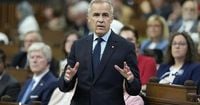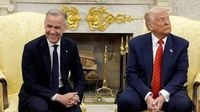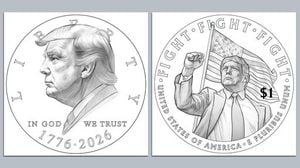Canadian Prime Minister Mark Carney is set to visit U.S. President Donald Trump at the White House next week, marking a pivotal moment in the often fraught relationship between the two North American neighbors. The announcement, made on October 3, 2025, comes at a time when diplomatic ties are being tested by trade tensions, renewed annexation rhetoric, and critical security negotiations.
According to the Associated Press, Carney will depart for Washington on Monday, October 6, 2025, with the high-stakes Oval Office meeting scheduled for Tuesday, October 7. The timing is significant: it precedes the first formal review of the United States-Mexico-Canada Agreement (USMCA), the landmark trade pact that underpins much of the continent’s economic activity and is due for reassessment in 2026.
Carney’s visit is more than a routine diplomatic call. It comes against the backdrop of President Trump’s revived talk about Canada potentially becoming the “51st state” of the United States, a notion he aired again earlier this week in connection with his proposed Golden Dome missile defense program. As reported by the Associated Press, Trump claimed, “They want to be a part of it. I said, ‘Why don’t you just join our country, become the 51st state and you get it for free.’”
This kind of rhetoric is not new, but it has gained renewed urgency as both countries prepare for the USMCA review. The agreement, which replaced NAFTA in 2020, governs over $2.7 billion (nearly $3.6 billion Canadian) in daily cross-border trade. More than 75% of Canada’s exports are destined for the U.S., making the American market absolutely vital to Canada’s economic health.
Carney, who won Canada’s election in April 2025 amid a climate of trade uncertainty and annexation threats from the Trump administration, has made improving relations with the U.S. a top priority. However, he faces a delicate balancing act. On one hand, he must protect Canadian interests in the face of U.S. pressure; on the other, he must ensure that dialogue remains open and constructive.
“Canada and the U.S. each launched consultations last month that will inform preparations for the first joint review” of the USMCA, Carney’s office said in a statement, as reported by the Associated Press. “The Prime Minister’s working visit will focus on shared priorities in a new economic and security relationship between Canada and the U.S.”
Yet, the relationship is anything but straightforward. As David Akin of The Canadian Press noted, “challenges with the U.S. President remain as volatile as ever.” The unpredictability of Trump’s approach—especially his tendency to use economic leverage and public rhetoric—has left Canadian policymakers wary. Robert Bothwell, a professor of Canadian history and international relations at the University of Toronto, told the Associated Press, “Trump is back on the 51st state theme. And he is somebody whose modus operandi is extortion.”
For Carney, there are political risks at home as well. Daniel Béland, a political science professor at McGill University in Montreal, warned, “A key political risk is that President Trump raises the 51st state issue again and seeks to publicly embarrass Prime Minister Carney during his visit. Another risk is that no apparent progress on trade is made, which would be bad news for the prime minister domestically, as the Conservatives accuse them of failing to successfully address the ongoing trade war with the United States.”
Trade has become a flashpoint in the bilateral relationship. Despite the USMCA’s promise of tariff-free trade for most goods, sector-specific U.S. tariffs—known as 232 tariffs—remain in place, hitting Canadian steel and aluminum exports particularly hard. Canada’s Minister of Energy and Natural Resources, Tim Hodgson, has called these levies “unfair and unjust,” emphasizing that the government is working to remove them, especially for the embattled aluminum industry.
Carney has argued that the USMCA remains a “unique advantage for Canada at a time when it is clear that the U.S. is charging for access to its market.” He points out that over 85% of Canada-U.S. trade continues to be free of tariffs, and the average U.S. tariff rate on Canadian goods is 5.6%—the lowest among all American trading partners. Still, the remaining tariffs have real consequences, and resolving these disputes will be a central topic during Carney’s Washington visit.
The economic ties between the two countries run deep. Canada is the top export destination for 36 U.S. states, and the daily flow of goods and services is staggering. According to the Associated Press, about 60% of U.S. crude oil imports and 85% of U.S. electricity imports come from Canada. Canada is also the largest foreign supplier of steel, aluminum, and uranium to the U.S., and provides 34 critical minerals and metals that the Pentagon views as vital for national security.
Security cooperation is also on the agenda, particularly Trump’s Golden Dome missile defense program. The U.S. president has floated the idea of extending the missile shield to Canada, but with a catch—access might come at a price, unless Canada were to join the U.S. outright as a state. While this suggestion is widely seen as tongue-in-cheek, it underscores the transactional nature of Trump’s diplomacy.
Carney, for his part, has tried to keep the relationship on an even keel. He reportedly asked Trump privately to stop referring to Canada as the 51st state during their last meeting at the White House in May 2025. Whether Trump will heed that request this time around remains to be seen.
The stakes for Carney are high. He will be accompanied by his minister responsible for Canada-U.S. trade, as well as his foreign minister and industry minister—underscoring the importance of this trip for both economic and diplomatic reasons. If progress can be made on tariffs and security cooperation, Carney could return home with a much-needed political win. If not, he risks further criticism from opposition parties who argue that his government has failed to stand up to Washington.
Meanwhile, the mood on the ground remains tense. Pete Hoekstra, the U.S. ambassador to Canada, has publicly expressed frustration over what he sees as rising anti-American sentiment north of the border. Travel by Canadians to the U.S. has plunged, reflecting a broader unease about the current state of relations.
Photographs from October 2, 2025, show Carney rising during Question Period on Parliament Hill in Ottawa, a reminder that while the prime minister’s attention is fixed on Washington, his political fortunes will ultimately be decided at home. As the USMCA review approaches and Trump’s rhetoric shows no signs of cooling, Carney’s ability to navigate these choppy diplomatic waters will be closely watched on both sides of the border.
How the upcoming White House meeting will reshape the Canada-U.S. relationship is anyone’s guess. But one thing’s for sure: the stakes have rarely been higher for both leaders and their countries.





